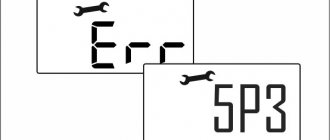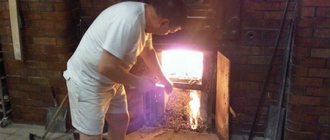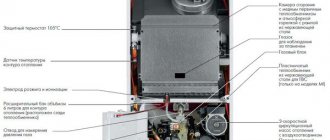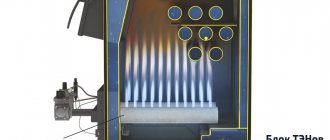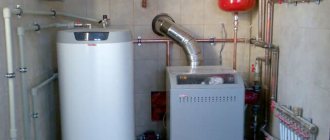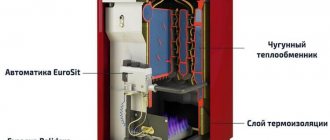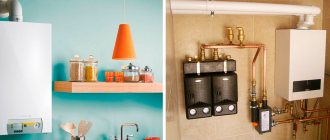Home / Gas boilers
Back
Published: 05/22/2019
Reading time: 2 min
10
32906
Gas boilers are designed to create comfortable living conditions. Double-circuit units provide the living space with heat and hot water at the tap. But it happens that a working boiler does not heat the water well and does not provide the necessary comfort.
The efficiency of the entire heating system depends on how the boiler operates. If there is a problem in the gas boiler itself, this can negatively affect the efficiency of the entire system and cause excessive consumption of energy resources. What happens when the boiler stops heating water? Let's look at the reasons and ways to solve this problem.
- 1 How does a boiler work?
- 2 The boiler does not heat water for heating
- 3 The boiler does not heat water for hot water supply
Operating principle of the boiler
To understand the causes of the breakdown, you need to understand how the boiler works. Double-circuit devices “Ariston”, “Baksi” and other models have several blocks. In the gas unit, ignition and combustion take place, the water unit is responsible for the water supply and pressure in the line. The smoke exhaust unit removes combustion products to the street.
As soon as you start the boiler, the pump is activated, which pumps water into the system. The gas valve opens. The liquid circulates through the tubes of the heat exchanger, and the burner evenly heats its body. Sensors control the heating process. As soon as the temperature reaches the set temperature, the gas supply is turned off and heating stops.
When the temperature begins to decrease, the sensors will send a signal to the control module - the heating cycle will start again.
When the mixer is opened, the flow sensor is activated. It signals the board to switch the three-way valve to DHW heating. When the mixer closes, the valve switches to the heating system. Some models are equipped with a “quick start” mode. Then the valve periodically switches, heating both the first and second heat exchangers.
Gas boiler does not heat hot water
Installing a gas boiler allows you to forget about cold water in radiators and taps. Double-circuit models are capable of simultaneously operating for heating and hot water supply (DHW) of a room. But what to do if the boiler does not heat the water? If you encounter a similar problem, our recommendations will help you find the cause and fix the problem yourself.
Operating principle of the boiler
To understand the causes of the breakdown, you need to understand how the boiler works. Double-circuit devices “Ariston”, “Baksi” and other models have several blocks. In the gas unit, ignition and combustion take place, the water unit is responsible for the water supply and pressure in the line. The smoke exhaust unit removes combustion products to the street.
As soon as you start the boiler, the pump is activated, which pumps water into the system. The gas valve opens. The liquid circulates through the tubes of the heat exchanger, and the burner evenly heats its body. Sensors control the heating process. As soon as the temperature reaches the set temperature, the gas supply is turned off and heating stops.
When the temperature begins to decrease, the sensors will send a signal to the control module - the heating cycle will start again.
When the mixer is opened, the flow sensor is activated. It signals the board to switch the three-way valve to DHW heating. When the mixer closes, the valve switches to the heating system. Some models are equipped with a “quick start” mode. Then the valve periodically switches, heating both the first and second heat exchangers.
Why the boiler does not heat well and does not reach temperature
No hot water? For what reasons does the equipment not work? Sometimes it's a matter of external factors. Let's take a closer look.
The device works, but does not heat or heats poorly
Airlock. Check to see if air has accumulated in the batteries. Use taps to remove excess air. If you don't have an air vent on your radiators, then you need to install one. By adjusting its tap, you can release the accumulated air in the system.
Also inspect the valve for blockages. Most often it becomes clogged with scale.
Clogged radiators . After cooling, drain the water from the pipes. If it is very dirty, run it through the batteries until it comes out clean.
Incorrect connection . If there is no hot flow, make sure that the diameter of the pipes corresponds to those stated in the instructions. Are the hoses connected correctly and the shut-off valves installed?
Low pressure in the line . It is not enough to open the valve and ignite the burner. Add water.
Scale accumulation in the heat exchanger. You may notice that the equipment takes a long time to heat up the liquid, and the batteries heat up slightly. Clean the radiator tubes from deposits. To do this, it is better to remove the unit, but this cannot be done in all models. Therefore, remove the casing and disconnect the device from gas and water. Connect the tubes from the pump to the heat exchanger and circulate the cleaning liquid through the system. Special products can be selected in the store. Then rinse the parts with running water.
The principle of operation of a double-circuit heating boiler
Using a gas unit as an example, let’s look at the operating principle of a double-circuit boiler. The design of the unit is a system of blocks, the operation of which is interconnected and controlled by a security system, which includes various sensors. The main blocks are a gas block, where ignition and combustion occurs, a hydraulic block, which regulates the flow and pressure of liquid, and a smoke removal block, which removes gas combustion products.
When the boiler is turned on, the circulation pump is initially started, then gas is supplied using the gas valve. Automatic ignition ignites the gas, and as the gas burns, the heat exchanger heats up, heating the coolant passing through it. In this mode, the unit will work for some time until the parameters that are regulated by sensors change.
Sensors monitor the temperature in the room, in the return flow, gas pressure, system pressure, draft flow, and the presence of flame. Temperature sensors can regulate the temperature at the inlet or outlet of the heating circuit. If there is a sensor on the return, when the set temperature is reached, the thermostat sends a signal to the electronic board, which, after processing it, turns off the gas supply.
In this case, the circulation pump will run for some time to cool the heat exchanger. This is done so that the remaining heat in the heat exchanger does not bring the coolant to a boil. After the water in the system has cooled to the set temperature, the electronic board will start the pump, the gas valve will open the gas and the entire cycle of operation of the double-circuit boiler will be repeated.
When a hot water tap is opened, the flow sensor is activated and the control board switches the three-way valve to heat the secondary heat exchanger. Heating hot water in the system is a priority, i.e. immediately after you open the hot water tap, the entire system will only work to heat this water.
When the tap closes, the reverse process occurs - the board transmits a signal to the three-way valve, it closes the DHW system and the unit again starts working on the heating circuit. Please remember that it will take some time for the unit to produce hot water from your tap.
Some devices are equipped with a “quick start” or “comfort” function. This function allows the boiler to periodically switch the three-way valve and heat the water in the secondary coolant.
How to increase the pressure in the boiler
If the reason is a malfunction of the expansion tank, then its volume was calculated incorrectly or the membrane was damaged. In this case, you should either more accurately calculate the required volume, or simply replace the tank.
If the pressure begins to drop immediately after the initial start-up, then this is normal. There is a large amount of air present in a circuit that has recently been filled with tap water. Over time, it will turn into bubbles and be removed from the pipeline, and the circuit parameters will return to normal. To remove bubbles faster, use a manual air release.
Before carrying out measures to increase the pressure in the system, it is necessary to ensure its tightness. To do this, you need to inspect the following parts of it:
- heating appliances - leaks often appear at the junctions with pipes, and leaks that occur between separate sections are also possible;
- pipes - even very small cracks can often lead to coolant leakage;
- fittings - often cause leaks;
- boilers - models with two circuits have a complex internal structure: for example, you should carefully inspect the circulation pump, three-way valve and heat exchanger.
Malfunctions of heating boilers
A dirty heat exchanger is a common reason for the lack of hot water in the DHW circuit.
Common boiler breakdowns include:
- coolant leak;
- water hammer;
- after turning on the burner, the lock is activated;
- the burner does not turn on;
- fuel burns unevenly, in waves;
- soot is formed;
- decreased productivity;
- During operation of the burner, the ignition is switched on;
- soot forms on the walls of the chimney and combustion chamber.
To resolve a problem, you must first determine the cause of the problem.
Built-in pump malfunction
The reason for the lack of hot water may be a clogged built-in pump.
An important part in the heating system is the circulation pump. The quality of heating and the functioning of hot water supply depend on its uninterrupted operation. There are several signs and causes of breakdowns:
- The unit makes uncharacteristic sounds. This occurs due to oxidation of the shaft, the entry of a foreign object into the structure, problems with the power supply, air in the pipes, dry running of the mechanism, and the appearance of cavitation.
- After turning on the boiler, the pump does not start. Perhaps there is no power supply, the fuse has tripped.
- After a short period of time after switching on, the structure switches off: limescale deposits in the stator shell.
- Hot water does not turn on in a double-circuit boiler.
Also, the reasons for poor operation of the circulation pump are poor pressure in the system, wear of the bearing, which causes additional vibrations in the line, and low pressure.
To troubleshoot problems, you need to check the presence of electricity, clean the pipes and other elements, replace failed parts, and remove foreign objects from the system.
The heat exchanger is clogged
You can clean the heat exchanger from scale using a solution of citric acid and an electric charge.
Heated gases are transported through channels, which are collectively called a heat exchanger. The design features are that the walls of the artery simultaneously serve as partitions of the water circuit, along which the coolant constantly moves, heating the metal surface. The combustion process is associated with the intense release of flue gases, partly consisting of soot and tar, which create a deposit inside the boiler, on the chimney. Therefore, the manufacturer recommends regularly cleaning the equipment at least once every 30 days and during the preparation of the device for the heating season.
We recommend: 10 best steel heating radiators - 2020 rating and tips for choosing
When soot settles on surfaces, the performance of the mechanism decreases, fuel consumption increases, and the risk of costly breakdowns and internal fire in the contaminated area increases.
Chemical cleaning of bithermal heat exchanger
Washing is carried out without dismantling the heat exchanger; to perform the procedure, you will need a booster with a volume of 20-30 liters. Before starting work, it is necessary to drain the coolant from the heating system using a Mayevsky tap.
Fill the booster reservoir with the flushing solution, and lower the hoses into the container, the free ends of which are connected to the heat exchanger pipes. Liquid movement is possible only under the action of a circulation pump; it must be connected to one of the hoses.
The ends of the hoses must be put on the heat exchanger pipes, and the free ends must be placed in a booster with flushing liquid, connecting the circulation pump. Work can be performed without removing the heat exchanger
It would be ideal to connect a reversible pump with the ability to change the direction of fluid flow. All that remains is to start the boiler for heating at a set temperature of 50-60 degrees and leave for 15 minutes, periodically changing the direction of circulation.
Chemical cleaning of the secondary heat exchanger
Flushing the secondary heat exchanger of a double-circuit gas boiler can be performed in a similar way to flushing a bithermic heat exchanger. However, you need to take into account that the secondary heat exchanger is easily removed, so you can improve the quality of cleaning by dismantling it.
To gain access to the heat exchanger, it is necessary to dismantle the front panel of the unit and move the control unit to the side. The heat exchanger is secured with two bolts at the bottom, which can be easily removed by unscrewing them.
It is most effective to place the heat exchanger removed from its original location for washing in a container with a salt-dissolving solution and boil it. Instead of a suitable household product, you can use a 20% citric acid solution.
Good results can be achieved by boiling the secondary heat exchanger in a washing solution
When cleaning any heat exchanger, the final stage is rinsing with clean water. This measure is necessary to remove traces of a chemically aggressive substance and stop its effect on the walls of the heat exchanger.
There is another way to clean the heat exchanger - hydrodynamic. Its implementation requires special equipment and pressure control at each stage of cleaning. Therefore, without special knowledge and skills, doing it yourself can be dangerous.
Regular cleaning of the heat exchanger will avoid the need to use very aggressive compounds and will make it possible to extend its service life. It is recommended to clean the heat exchanger annually at the end of the heating season.
Problems with the heating circuit
The pump must be selected according to the requirements of the heating circuit.
Malfunctions in the operating mode of the heating circuit are not always associated with a malfunction of the main heating element. If the boiler works, but does not heat the batteries, the reason must be sought in the wiring itself.
List of main heating circuit malfunctions:
- the filter on the return line or the needle tap (Maevsky tap) is clogged;
- insufficient power of the circulation pump;
- the rules for installing a heating circuit with natural circulation have not been followed.
Any of the above problems must be resolved before the start of the heating season. Otherwise, the room may be left without heat for several days, since the repair involves completely draining the coolant.
So, why doesn’t the boiler heat the batteries if everything worked fine over the previous years? The reason is a dirt plug that has formed on the heating circuit filter and completely blocks the coolant flow. It can be solved simply - the water is drained from the pipes or its circulation is blocked using bypasses, and the filter is cleaned. To prevent a recurrence of such a situation, it is necessary to completely replace the coolant with parallel flushing of the entire circuit.
In a gravity system, the slope of the pipes is key.
The second reason why the boiler works but the radiators are cold is the insufficient power of the circulation pump. The performance of the device is not enough to pump the entire volume of coolant in a timely and efficient manner. Or the heating system in the house has branches that are located at a significant distance from the pump. As a result, the circulation pump overheats, the heating equipment operates with excessive energy consumption, and the radiators remain cold. The solution is to change the coolant pumping device to a more powerful one.
If the house has a two-pipe heating circuit with natural circulation of water, and during the heating season it is often noticed that the boiler is on and the radiators are cold, then the reason lies in non-compliance with the slope of the main line. According to regulatory documentation, only a pipe slope of 10 mm per linear meter in a heating system with natural circulation will ensure normal coolant movement. The result is uniform heating of the batteries throughout the house. If there is no slope, the coolant stagnates, which negatively affects the temperature of the radiators. The problem can be solved by completely redoing the wiring.
Modulation errors on the burner
To heat running water, in most cases a boiler power close to maximum is required. In modern boilers, the burner power is regulated over a wide range. The adjustment occurs by changing the amount of gas supplied by the gas valve. The amount of adjustment is determined by the control board depending on the operating logic and settings. The process can be observed visually by the height of the flames on the burner.
If the boiler settings are set to 100% boiler power in DHW mode, but visually the flames on the burner are weak, or obvious interruptions are visible, then you should check:
- setting the gas valve (static and dynamic gas pressure)
- control board
Such checks should only be performed by a qualified person.
Three-way valve
A three-way valve is installed in boilers with two heat exchangers. When a signal is received from the flow sensor, the electronics gives a signal to the valve and the heated water from the first heat exchanger is sent to the second heat exchanger, where the heat is transferred to the passing tap water. If, for example, no actual switching occurs (the valve is faulty), then the coolant will continue to circulate in the heating circuit and no heat transfer to the hot water circuit will occur.
If, for example, a valve only partially closes the heating circuit due to a malfunction, then there will be problems with insufficient heating of hot water, since part of the heat will go to the heating system.
We recommend: Insulating walls from the outside: types of external insulation for a brick or concrete building, density of slabs and rating of materials
Problems with the flow sensor
A possible reason why a gas boiler may stop heating water is a problem with the flow sensor. The device is a small fan that rotates under the influence of water flow. As a result of rotation, a signal is sent to the control board to heat the water. Due to clogging, the fan may stop rotating.
You can clear the blockage without dismantling the device. To clean it, just open and close the water supply tap several times. If such actions do not give the desired result, you will have to remove the sensor and clean it.
To do this you need:
- Disconnect the gas boiler from the electrical network;
- Turn off the water supply tap;
- Drain the water from the unit.
Typically, the flow sensor is secured with a bracket, by removing which you can easily remove the device. The assembly is removed completely; to remove the inner part, you need to turn the parts in the groove. During disassembly, you should clean the filter mesh and remove the turbine.
Often, turbine blades are covered with a layer of rust that needs to be thoroughly cleaned. If you remove the three clamps, you can remove the turbine itself to clean the internal plane of its landing. Now all that remains is to reassemble in reverse order.
When disassembling the flow sensor, you need to clean the filter and turbine blades
If cleaning the flow sensor does not bring the desired result and there is no hot water, you will have to replace the entire assembly.
Why does the boiler not heat water for the heating system?
There can be many reasons why a gas boiler does not heat water for heating. We will consider the main ones and ways to eliminate these reasons below.
The boiler turns on, but the heating does not heat.
Possible causes and their elimination:
- First of all, you should check whether air has accumulated in the batteries; using taps, you need to remove air from the system. To avoid air venting, install an air vent.
Battery bleed valve
It operates on the principle of an expansion tank, without reducing the pressure in the system. After the unit has been idle for a long time, check the valve; it may become clogged with scale;
- Batteries are clogged, what should I do in this case? It is necessary to drain the water from the cooled batteries. If you see that water flows out with debris, and sometimes black slurry may flow out, you need to flush the system to clean water;
- incorrectly made connection and piping. The diameter of the pipes may be incorrectly selected, shut-off valves may not be installed correctly, or the heat exchanger may be incorrectly connected. Check the manufacturer's recommendations in the instructions and correct any errors;
- at reduced pressure the unit also does not heat well, add water to the system;
- the appearance of scale in the heat exchanger. It is necessary to flush the heat exchanger from deposits. Not all models make it easy to remove the heat exchanger from the device. Where this is difficult to do, you can clean it without removing it. To do this, the boiler must be turned off and cooled.
Connect pump hoses with a filtration system to the inlet and outlet and rinse the heat exchanger with a special cleaning liquid. Afterwards, be sure to rinse the boiler with clean water to remove chemical residues, otherwise the remaining particles of the product can lead to corrosion of the heat exchanger, pipes and heating batteries.
Flushing the heat exchangerThe use of reagents as coolant additives significantly reduces scale formation. But not all models allow the use of antifreeze. Manufacturers Ariston (Ariston), Arderia (Arderia), Navien (Navien), Buderus, Viessmann (Wismann), Electrolux (Electrolux) prohibit the use of antifreeze, recommending the use of distilled water.
In the instructions for the models Rinnai, Baxi, Vaillant, Celtic, Ferroli, AOGV 11 6, Beretta, Bosch, Neva Lux, Protherm, Junkers, Koreastar (Koreastar), Daewoo allows the use of antifreeze. Please note that not all antifreeze is suitable for these boilers.
- contamination of the heating water filter also becomes the reason why the boiler does not heat the batteries well - clean the filter under a strong stream of water, after turning off and cooling the boiler. If the contamination is severe and cannot be cleaned, replace the filter;
- The coolant heating temperature is set too low, increase the temperature;
- incorrect operation of the circulation pump or its overheating also becomes the reason why your unit began to heat the batteries poorly, adjust its power;
- incorrectly selected battery design. The batteries must correspond to a specific heating mode, since each type of radiator has an individual heat transfer value depending on this mode.
Boiler doesn't heat water? There is only one reason - scale
I set it to 27 degrees (lower is not comfortable), the boiler works for a long time, the coolant heats up to the maximum (80 degrees C), then when it gets hot it turns off.
He may even “fall asleep” for a long time (for half a day or more), although the rooms are already getting cool and it wouldn’t hurt to turn on, but I look at the remote control - the temperature shows 27, although there is a feeling that it has dropped significantly lower. Either the sensitivity of the remote control is very uncomfortable +-1 degree, or this is some kind of malfunction. Who can say anything on this issue. The boiler has been in operation for 2 years.
Answer: I can assume that the remote control is poorly positioned; there is no air circulation around it.
Question: I don’t like the operating mode of the Arderia esr 2.20 ffcd gas boiler when regulated by coolant temperature. I will describe the operating mode in more detail: Let's say the temperature of the coolant has dropped to the lower limit at which the gas supply is activated and the coolant is heated.
Moreover, heating occurs within no more than half a minute, while the pump continues to circulate water. Over the next half a minute, during the circulation of the coolant, it cools down again to the lower limit and heating is turned on again, and so on with virtually no pauses. I haven’t changed the settings (factory settings) and I don’t know how to do it.
The only thing I checked was the parameters given in the manual, they are the same. Previously, I had not noticed this mode of operation, because it was the other way around: at first, after the boiler was activated, the coolant circulated without heating, then the heating was turned on, the pump continued circulation for a certain time, then it turned off and there was a pause in its operation, now this pause simply does not exist.
Sometimes during the day, in order not to load the boiler, I turn on the timer mode (but the minimum value there is one hour). I would like to hear your opinion on how the boiler works and how to put it in order?
Answer: The other day there was an error A8, the boiler was puffing like a steam locomotive, the burner ignited and went out after 30 seconds. This happened after heating the water in the heating system and flushing the heating circuit in the boiler. The problems have disappeared. I recommend that you also start cleaning the boiler.
Question: We installed and started up the Arderia 2.20 boiler. The hot water supply is either cold or hot, the gas is not cut off at this time. After 20-25 minutes it is constantly hot. Another thing is that the water becomes at a comfortable temperature (not cold) only with a small pressure at one point; if you open hot water in another place, the boiler may go out. I read the instructions, I am inclined to think that it is necessary to flush the DHW heat exchanger. Can you tell me anything else?
Answer: Maybe your heating system is airy, and while air and water are circulating through the circuit through the heating heat exchanger, the water temperature is unstable. I think you can check this by turning off the boiler for half an hour and turning on the heating and listening to the sound of bubbling in the boiler; if it is bubbling, then the air is bubbling, if not, then probably the three-way valve.
If this is the diagram of your boiler, then there is a high probability that the three-way valve is faulty because it is located at the outlet of the heat exchanger and very hot coolant comes out through it and destroys the 3-way valve. On most boilers, the 3-way is located on the heating return and operates at a lower temperature.
Question: A wall-mounted boiler Arderia 2.20 is installed and connected in the house. The problem is that it doesn't heat hot water. When the mixer is opened, cold water comes out, this happens in both summer and winter mode. When the mountains open water, the flame turns on and it heats the heating circuit. At first I thought it was a three-way valve, so I bought a new one and installed it. But the problem was not solved; everything remained the same. Tell me what to do?
Answer: Diagram: The hot water tap was opened - flow began - the DHW flow sensor was triggered - a signal was received on the control board - the control board processed the signal and sent a command to the three-way valve - the three-way valve worked and redirected the heating water to the plate heat exchanger - heating of the cold household began. water in the secondary plate heat exchanger - mountains came out of the water tap. household water.
What is the weak link in this algorithm? DHW sensor - board - three-way valve. Let's start in order with the sensor. The sensor may simply not work due to the fact that the pressure that creates the water flow is weak or there is increased hydraulic resistance, i.e. the filter is clogged or there is dirt in the sensor itself. A clogged secondary also creates increased hydraulic resistance, but in this case, heating of the hot water supply would most likely occur in pulsation mode, and would not be absent at all, especially not at all.
Gas boiler Navien, main faults and their elimination
Do-it-yourself repairs require certain knowledge and skills in working with gas equipment. There is a special manual that describes the main fault codes. There are no repair instructions provided for users. The manufacturer assumes that troubleshooting will be carried out exclusively by service centers.
But many breakdowns can be fixed on your own without wasting time and money on a professional technician. To do this, it is enough to familiarize yourself with the main malfunctions and their elimination.
Navien gas boiler does not start
If the system does not turn on the control panel, then the problem is usually a lack of power from the electrical network. If the power supply is turned off by utilities, you should wait until the supply is restored. To understand how to turn on the equipment, just plug the cord into an outlet.
A common problem is the gas boiler turning on and off frequently. The source of the malfunction is an incorrectly installed circulation pump. The heating often turns off when the temperature range is incorrect. Also, the equipment turns on and off every 5-7 minutes in the absence of a thermostat.
The Navien boiler does not reach the set temperature
The most common malfunction of a Navien gas boiler is that the system does not heat up to the specified parameters. To fix the problem, you need to clean the heat exchanger using household plumbing chemicals or specialized compounds. To do this, the device is dismantled, the selected solution is poured into it, after which the part is thoroughly washed with a large amount of water. If the boiler does not heat hot water, then you can clean the heat exchanger of the DHW circuit in the same way.
The Navien boiler quickly gains and drops temperature
If the Navien gas boiler quickly heats up and cools down, then the fault should be sought in the heating system. You can adjust the pump speed to force fluid movement or remove air pockets.
We recommend: Gas heaters for tents - how to choose, review of the best models, prices and reviews, where to buy
During diagnostics, it is necessary to inspect the filtration system and the lumen of the heat exchanger. You may also need to replace the antifreeze. Spare parts for Navien gas boilers are freely available - they can be ordered online or purchased in a specialized store.
Malfunction of the boiler ventilation system
If you do not use Navien Deluxe floor or wall heating equipment for a long time, a lot of dust accumulates inside, which negatively affects the operation of the fan. To fix the problem, you will need to clean and lubricate the system.
Water oversaturated with oxygen
During natural circulation, water bubbles form, which burst and cause noisy operation of Navien Ice 24 and other models. If you add membranes to the system, the problem will disappear.
Pressure failures
Failures in water pressure of Navien heating devices are usually associated with leaks. The coolant penetrates into all small cracks, which affects the operation of the equipment. Also, the reasons include a malfunction of the three-way valve or secondary heat exchanger.
The most common Ariston boiler error codes and troubleshooting methods
To quickly understand what happened to the heating device and why the double-circuit gas boiler does not heat hot water, it is worth familiarizing yourself with the list of Ariston boiler errors, grouped by component. In some cases, correcting errors and troubleshooting an Ariston gas boiler can be done independently, including by replacing parts.
Error 101 gas boiler Ariston 24 ff, interpretation
The list of error codes starts with 101. If such a code is displayed on the equalizer (display) of the Ariston 24 ff device, this indicates overheating of the coolant. The failure occurs due to:
- increased pressure in the area of the gas valve;
- insufficient speed of water movement (this problem arises due to blockages in the filter, scale, pump breakdown);
- temperature sensor failure.
Read more: Why does a gas boiler go out? Main reasons
Error 103, 104, 105, 107. What to do
Errors 104, 103, 105 or 107 appear when the coolant flows incorrectly, there are obstacles in the movement, or as a result of deterioration in pressure. Difficulty in moving the carrier may be due to the presence of air pockets in the system.
There is a simple solution: for a 24 kW double-circuit boiler - hold down “Mode” for ten seconds; for Ariston Uno - hold “Reset” for about six seconds.
After these steps, the pumping apparatus will operate for five minutes, pumping out air without ignition. After the procedure, it is worth assessing the pressure level. The normal value is 1.2 Bar.
Error 108, how to fix it
Error 108 is caused by weak pressure in the heat exchanger, tank, pipes, mountings on the gas boiler, or the reasons indicated in the previous paragraph. Error code 108 means that it is worth inspecting the tank and other spare parts for leaks, and make sure that the membrane part in the expansion tank is in good condition.
Error code 109
Error 109 in Ariston indicates increased pressure (more than 3 Bar). To eliminate such a nuisance, you need to bleed the air (using a Mayevsky valve). The second cause of the 109th breakdown may be a broken heat exchanger that mixes water of different temperatures.
Error 302
Such a failure indicates a breakdown in communication between the display and the control board. Error 302 is caused by disconnection/oxidation of contacts. If such a malfunction occurs, you can try to repair the Ariston gas boiler yourself. To do this, you need to check the reliability of the contact connections and, if necessary, clean them.
Error 304
Code 304 is a broken electronic board. You should find a place that sells spare parts for Ariston gas boilers and purchase a replacement part.
Error 501, what it means and how to fix it
Error 501 means that the device does not start due to lack of ignition flame. The heating unit can be turned on by correcting the following causes of failure:
- lack of gas (you need to make sure it is present, open the gas valve);
- control board failure;
- violation of the electrode connection with the ignition control module;
- breakdown of the ionization electrode (it is necessary to clean the contacts, check the correct placement of the comb: a distance of eight millimeters must be maintained between the parts);
- reduction in the power of the smooth ignition system;
- leakage of electric current (remove the breakdown in the electrical network: the voltage should be 10 V).
The boiler does not ignite, the display shows error 607
If an Ariston double-circuit gas boiler shows the numbers 607, the contacts of the fan relay have stuck together and it simply worked before ignition.
Error Sp1
Sp1 or 5p1 reflects failed ignition. At the same time, 5p2 indicates a repeated unsuccessful attempt to light the wick. Causes:
- poor air flow;
- oxidized ionization electrodes;
- low gas pressure (it is difficult to immediately say why the pressure drops, so detailed diagnostics will be required).
Sp3, 5p3 (flame break)
If the wall-mounted gas boiler Ariston 24 gives one of the indicated designations (error sp3 or 5p3), there may be a problem with the flame. Eliminating the error of flame separation from an Ariston gas boiler is associated with cleaning the chimney. It is too clogged with dust and soot or is not arranged correctly, so the fire is immediately blown out or the so-called flame separation occurs.
Error 025
When the boiler shows error 025 constantly (it can also look like this: “e25”), this indicates that the maximum permissible temperature of the boiler has been exceeded (see the paragraph about the 101st error).
What to do if 6p2 lights up on the display
A light on the display showing error 6p2 or 6p1 tells the user that the room with the unit is not properly ventilated: either it is not ventilated enough or combustion products are not removed.
Ways to solve the problem
The problem can be solved in ways that require significant investment, for example:
- using an indirect heating boiler together with a boiler,
- purchasing a new boiler with a built-in boiler.
However, there is a less expensive, but very productive method - inserting an electric storage heater into the hot water supply circuit. Moreover, for this purpose, any standard heater with a volume of 30 liters is quite suitable, regardless of the manufacturer.
Use a water heater
A water heater embedded in the hot water supply circuit acts as a buffer tank. Its purpose is to equalize the temperature of hot water and smooth out possible temperature surges. The storage water heater and the gas boiler heater are set to the same operating temperature.
Even if the hot water taps are turned on simultaneously at different points of its intake, all users will initially receive water from the storage tank. The time spent waiting for a comfortable water temperature is reduced. Unproductive water consumption is reduced.
Turning the hot water supply on and off at any point of intake causes a temperature difference in the water leaving the gas boiler. However, this water enters the lower part of the water heater, and when it leaves the upper part, the temperature jump is completely smoothed out.
Connecting the water heater through a ball valve allows you to switch to a conventional gas boiler operating system at any time, which can ensure uninterrupted hot water supply in the event of a water heater failure.
Using a bypass jumper with a tap in close proximity to the boiler allows you to exclude the boiler from the hot water supply system. If the boiler is under maintenance, using the existing water heater will ensure uninterrupted operation of the hot water supply system.
Use an expansion tank
In winter, when the boiler's heating circuit is activated, any activation of hot water results in the heating circuit being turned off so that the hot water supply circuit can turn on. In the summer, when the boiler's heating circuit is not activated, each turn on of the hot water leads to the gas boiler turning on.
Often the user opens the hot water tap to simply rinse his hands. The boiler turns on or switches, hot water flows through the pipes. But the user may simply not wait for it, washing his hands with cold water.
Meanwhile, frequent and useless turning on and switching of the boiler “eats up” its operating life. A possible solution is to install a small expansion tank. It is installed in front of the water heater. If there is such a tank, for the first time after turning on the tap, hot water enters the pipe exclusively from the water heater due to the increase in pressure in the tank. Thus, in case of short-term use of hot water, there is no need to turn on and switch the boiler.
It is recommended to use a tank designed for hot water supply. Using a tank intended for heating will cause an odor because its membrane is made of rubber.
Use a recirculation pump
The best option is that the water heater is located in close proximity to the hot water intake points. The closer it is, the faster the hot water enters the tap, the more efficiently it is used. If this option for installing a water heater is not possible, then it is recommended to install a recirculation pump.
The pump is installed in the section between the water heater and the hot water intake points, ensuring the slow movement of hot water through the pipes. In addition, if you install a heated towel rail in this section, it will perform its direct function at any time of the year, regardless of the operation of the heating circuit of the boiler.
Prevention and cleaning methods
The heating circuit in the boiler is clogged with scale and needs to be cleaned
. Many gas boilers do not heat water because preventive measures have not been taken beforehand. Heating equipment requires timely maintenance:
- cleaning;
- replacement of components and worn parts, gaskets, seals;
- gas adjustment;
- pressure control.
It is also important to ensure that the coolant level in the expansion tank is correct.
If the Baxi boiler does not heat water due to contamination of the OS elements, it is necessary to clean it. There are several ways:
- Mechanical. It is produced with scale thickness from 1 mm to 3 mm using equipment made of a flexible shaft, with a drive and cutters.
- Hydrodynamic. Occurs by flushing pipes with high pressure water.
- Chemical. For the event, specialized equipment and a composition of aggressive effects on the surface are used.
- Electric discharge. The method allows you to remove high-strength contaminants. A working cable with a certain power/frequency of electric discharge is transported along a water-filled line.
The cleaning method is selected taking into account the type of boiler, the nature of the contamination and the thickness of the scale.
